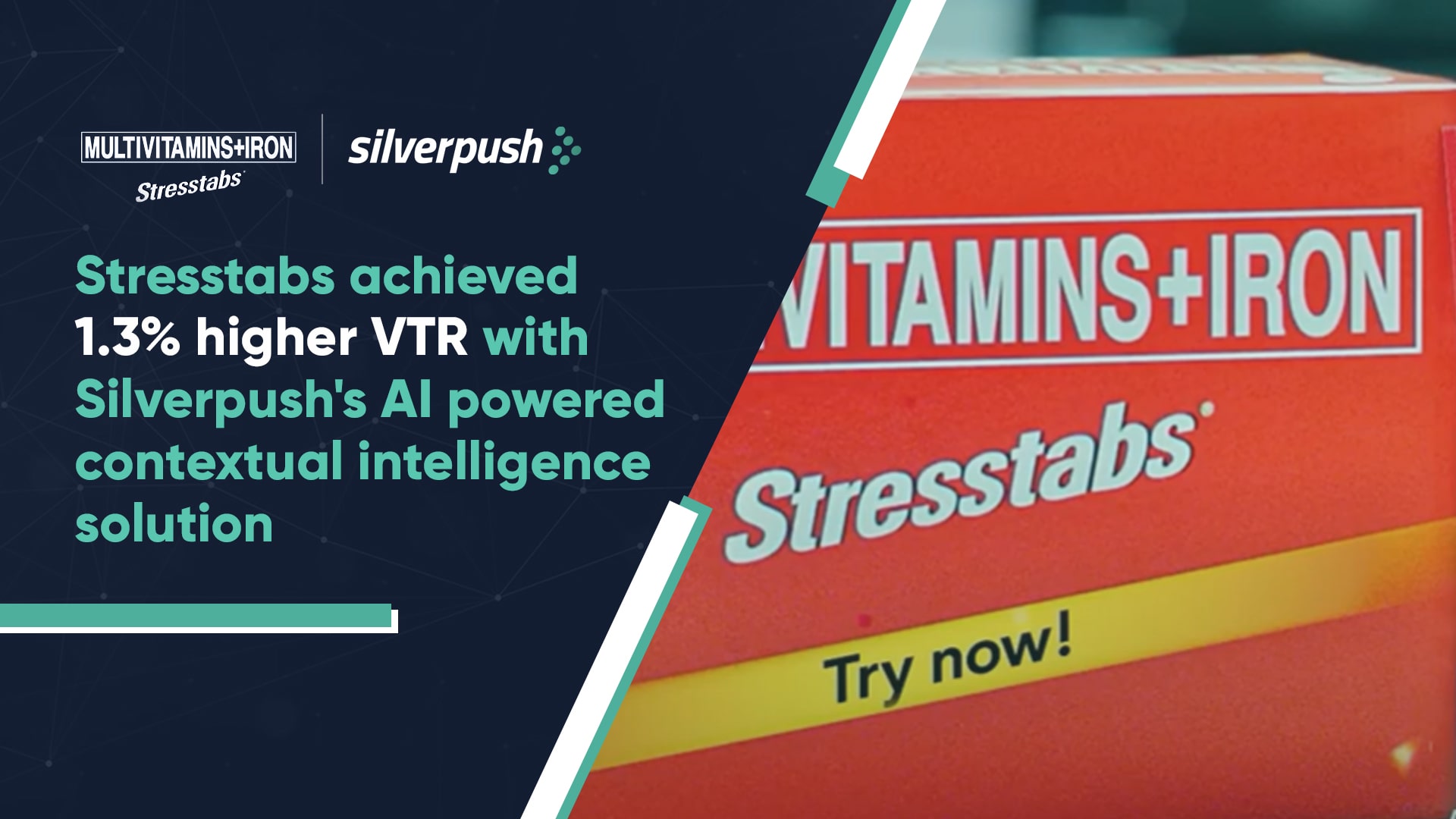Interactive Video Ads: Turn Passive Viewers to Active Participants
PUBLISH DATE: 28 March 2024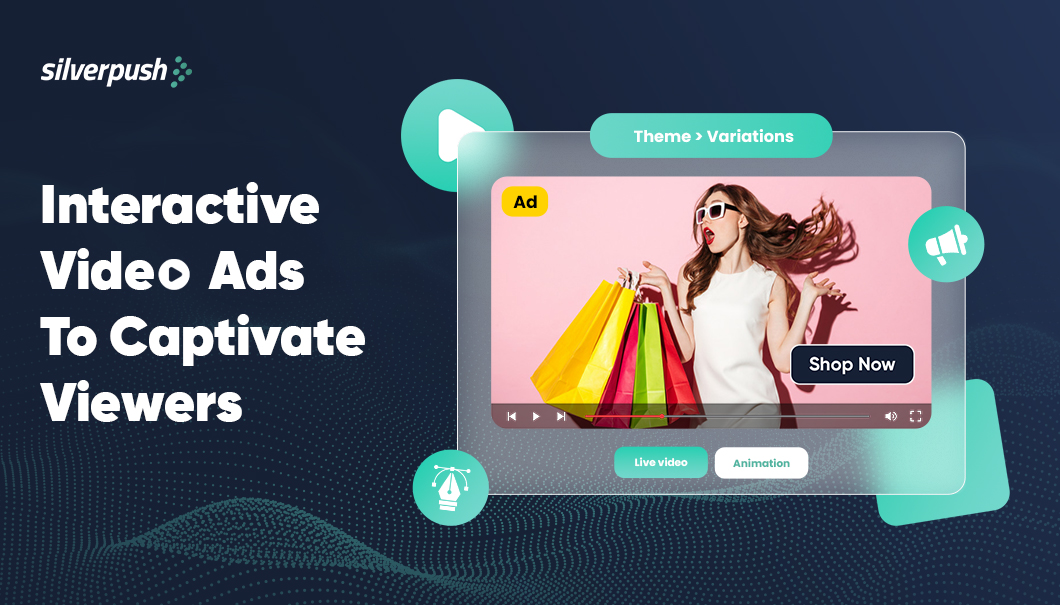
Interactive video ads signify a revolutionary change in digital advertising, turning passive spectators into dynamic participants. Through the smooth integration of interactive elements such as touchpoints, quizzes, and clickable features, these ads present an unparalleled avenue for brands to connect with their audience. Viewers are no longer just observers but are encouraged to engage deeply with the ad content, making choices and initiating actions that steer the storyline.
According to the State of Video Marketing report, 17% of video marketers intend to incorporate interactive video into their video marketing strategy. But now, before we get ahead of ourselves, let’s understand what is interactive video advertising, the reason why advertisers need to implement creative intelligence in their advertising media plan, and how to choose the best tech partner to get started with interactive video ads.
What is Interactive Video Advertising?
By definition, Interactive video advertising allows consumers to engage and interact with an ad, nurturing communication between brands and their audiences. This dynamic approach enables brands to establish and cultivate meaningful connections with their audience.
Interactive v/s Linear Video Ads
Traditional linear video ads typically allow limited interaction, such as play, pause, rewind, and fast-forward functionalities. In contrast, Interactive videos empower viewers to interact directly with the content using various digital actions like clicking, dragging, scrolling, hovering, and gesturing. This interactivity is facilitated through several tools, including:
- Hotspots: clickable areas within the video that may lead to external web pages or reveal additional content within the video itself, like product details.
- 360 views: enabling users to explore the video environment by dragging the screen to view in different directions.
- Branches: offering viewers multiple paths to customize and control the content they see.
- Data inputs: integrating form fields where users can input information like their name, age, etc., directly within the video.
- Quizzes: combining interactive buttons and branching to deliver assessments and provide personalized results at the conclusion of the video.
These functionalities enhance viewer engagement, making the video experience more enjoyable, memorable, and interactive.
Reasons for Brands to Adopt Interactive Video Ads
Giving viewers choices is increasingly popular, exemplified by Bear Grylls’ innovative use of interactivity in his Netflix series, “You vs Wild.” Similarly, on the advertising front, interactive video ads offer brands a powerful tool to engage consumers and convey messages more effectively.
There are several key factors that contribute to the rapid adoption of these formats:
1. Short Attention Time Span of Consumers
The internet has evolved into a fierce arena where capturing the attention of an easily distracted online audience is a constant challenge. In response to this, snackable content has emerged as a solution to cater to the short attention spans of the masses. On social media platforms, brands have effectively utilized snackable content to engage their audience. However, on the broader web landscape, its interactive layers are emerging as a highly effective strategy for capturing attention and encouraging users to engage with brands on a deeper level. Interactive elements within content not only grab attention but also invite users to actively participate, creating a more immersive and memorable experience. This deeper level of engagement nurtures stronger connections between brands and their audience, ultimately driving brand awareness and loyalty in a crowded digital space.
2. Higher Engagement
Encouraging users to engage with an advertisement by incorporating gamification elements is an effective strategy for conveying a brand message. Research indicates that interactive video ads lead to a 47% increase in the time spent with the ad. Additionally, when users interact with these ads, advertisers benefit from triple the amount of time spent engaging with the consumer.
3. Better Brand Recall
Interactive video ads, when executed effectively, are not just cool and innovative; they also excel in achieving what every advertiser aims for memorability. Research indicates that these ads leave a lasting impression, so much so that even if users don’t actively engage with them, they are still 32% more likely to remember the interactive ad compared to a linear ad.
4. Measure KPIs beyond views
Linear video ads traditionally focus on viewability and completion as KPIs, but interactive video ads offer deeper insights into user engagement. Tracking interactions with interactive elements provides valuable data, allowing brands to define KPIs based on campaign goals. This enables better measurement of ad effectiveness and optimization strategies.
How to Choose an Interactive Video Company?
Finding the right agency partner is crucial when embarking on your first interactive video project. It’s essential to choose a partner whose experience, skills, and capabilities match your requirements. That’s why we’re excited to introduce you to Crafters, a creative intelligence solution that can help bring your interactive video vision to life.
Our proprietary technology and engaging creatives turn your ads into immersive journeys, transforming brand stories into great captivating experiences.
1. Experience a sales boost like never before with Shoppable Videos!
These interactive masterpieces empower viewers to make purchases directly from the video itself. Explore, interact, and shop seamlessly as you watch, turning passive viewing into instant gratification. Elevate your sales strategy with Shoppable Videos today!
2. Reach the Right Audience in the Right Context at the Right Moment
Deliver ads on relevant platforms like CTV and Open Web, reaching viewers actively engaged in your niche. Crafters generate ads using non-personally identifiable information such as weather, geography, and time of day, ensuring user privacy and compliance with evolving regulations.
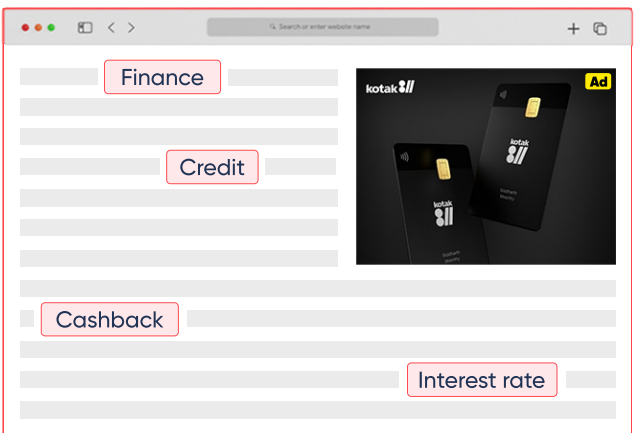
Conclusion
Digital video advertising expenditure has been on a remarkable upward trajectory, with substantial year-on-year increases. Although the global online advertising market is expected to mature and experience slower growth in 2024 and beyond, one niche that will maintain its prominence is video advertising. Forecasts predict a year-over-year growth of over 6% for video advertising in 2024. (Source: Statista).
Interactive video ads are poised to become a cornerstone of this growth, transitioning from a niche market to a mainstream advertising format. Brands are taking notice of these trends, and we anticipate witnessing a surge of highly original and creative interactive video ads in 2024 and beyond.
The possibilities are endless. Work with one of our interactive experts for your next campaign. Get started now.
The Olympics: More Than Just A City-Wide Event, A Global Marketing Opportunity
PUBLISH DATE: 14 March 2024
Remember the electrifying moment when Michael Phelps clinched his 8th gold medal by a mere 1/100th of a second? Or the breathtaking sight of Simone Biles flawlessly landing her Yurchenko double pike? With such iconic moments set to captivate audiences worldwide, the upcoming Summer Olympic Games in Paris present an unparalleled opportunity for brands to align themselves with these historic and inspiring feats in sports.
The allure of the Olympics is undeniable. Every four years, the world unites to witness the pinnacle of athletic achievement, with the host city taking center stage. From Barcelona’s cultural explosion in 1992 to Rio’s awe-inspiring spectacle in 2016, each game has left a lasting impression.
Paris 2024 promises to be no different. According to Euromonitor International, Paris anticipates welcoming an additional 3 million visitors during the Games generating a surge in revenue for local businesses.
Welcome to the kickoff of our four-part Olympics blog series! In Series 1, we’ll delve into five compelling reasons why marketers worldwide must begin gearing up to position themselves as Olympic contenders.
Olympics Advertising Stats to Kickstart Your Gameplan
Audiences Atop the Leaderboard
According to NBCU, The Summer Games held in Tokyo were the most significant mass audience event of 2021 and 2022, drawing in diverse viewership from various demographics. In Paris, the upcoming Games are anticipated to attract four times the streaming minutes compared to Tokyo, making it an even more substantial platform for brands to connect with consumers. Unlike niche events, the Olympics appeal to a wide range of audiences, including men, moms, millennials, and people from diverse ethnic backgrounds.
Brands that choose to invest in commercial time during the Olympics stand a higher chance of capturing consumers’ attention. However, seizing this opportunity requires both strategic planning and tactical execution.
The Olympic Halo Helps Outpace the Competition
The Tokyo Games are heralded as the most digitally accessible Games in history, poised to surpass the coverage and engagement of the lackluster TV ratings seen during the Rio 2016 Games. Here are some key digital highlights:
- 61% of UK population (35 million) British viewers tuned in to watch the 2016 Rio Olympics on BBC.
- An average of 15.5 million viewers saw 2021 Tokyo Olympics in primetime coverage in the U.S.
- Over 218,000 coverage hours across 250+ digital platforms, doubling the TV coverage of Rio 2016.
- More than 9 million hours of content streamed on the Olympic player, with a daily average of 1 million unique viewers for live streaming and on-demand content.
- NBC alone exceeded 2.5 billion live streaming minutes, marking a significant increase compared to all previous Olympic Games combined.
- Record-breaking social media engagements, with over 4 billion impressions generated.
Here Are 5 Reasons Why Marketers Around The World Shouldn’t Wait To Capitalize On The Olympic Spirit
Paris Spreads The Game Across The Nation
From Handball and Basketball matches near Lille to soccer showdowns in Bordeaux, Lyon, and Nice, along with sailing competitions off Marseille’s shores and shooting contests near the scenic Loire Valley at Châteauroux, the Paris Games are a nationwide spectacle. Each venue will draw its own crowd of spectators keen on exploring local attractions between events.
Each location will attract enthusiastic spectators eager to explore local gems when not cheering on athletes. Tahiti, the first overseas territory to host an Olympic event, adds an exotic twist, offering breathtaking, thrilling jungle adventures, and even wine tours.
Olympic Visitors Are Adventurous Explorers
Olympic attendees bound for events in Paris will undoubtedly take advantage of ample opportunities to explore the capital. Plus, with seamless access to Western Europe’s most expensive train network, their journey doesn’t have to end there.
Historical data from past Olympics reveals a significant portion of visitors’ expenditures occurring beyond the host city. For instance, during the 2012 London Games, the average visitor extended their stay by 22% compared to typical tourists visiting the UK, allocating 27% of their spending to regions outside of London.
Paris In Motion, Opportunity On The Move
It’s not just international visitors who will venture beyond Paris during the Games. Recent Olympics have witnessed a trend of internal migration, with residents capitalizing on the opportunity to rent out their homes and explore other regions of the country.
Vacation rental companies like Airbnb alone expect to facilitate over half a million Parisians in renting their properties during the Games. These enterprising individuals, seeking new experiences in different parts of the country, will inject fresh energy into local shops, restaurants, and cafes.
Fans will be there in spirit via devices, apps, and channels
Fans are eagerly anticipating the upcoming Olympic Games! Over the past year and a half, spurred by a global pandemic, we’ve witnessed a rapid surge in consumers’ embrace of digital-first TV, particularly through connected TV, and subscriptions to streaming services. However, it’s worth noting that a considerable portion of the coverage will be consumed in a time-shifted manner due to the significant time zone difference between Tokyo and regions like the US (13 hours ahead) and the UK (8 hours ahead).
Sports Participation Takes Center Stage
Every Summer Olympics captures the attention of a global audience, consistently exceeding 3 billion viewers, solidifying its position among the most-watched sporting events around the world. The Games provide a platform for sports often underrepresented in mainstream media, showcasing the athleticism and dedication required in disciplines like rowing, kayaking, climbing, and surfing.
Additionally, the Olympics consistently fuels a surge in participation rates for established sports like boxing and athletics. Notably, after the 2012 Games, bike retailers in the UK reported a remarkable 15% jump in sales source (Cycling Weekly), highlighting the global impact of the Olympics on sporting goods, venues, and local clubs.
Final Take
The Paris 2024 Olympics offers a unique opportunity for businesses worldwide to reach a vast, engaged audience. By understanding the event’s wider footprint & implementing strategic marketing initiatives, businesses can transform themselves into Olympic contenders, regardless of their location. This is the debut article in our series, dedicated to unlocking the potential of the Paris 2024 opportunity, no matter where you are. Stay tuned for the next chapters as we delve into seizing key moments in the Olympic Games.
Lights, Camera, Insights! How Advertisers can Win the Oscars
PUBLISH DATE: 11 March 2024
As the Oscars draw near this week, let’s delve into the captivating world behind the glamor and glitz!
🎬 Exploring pivotal categories and emerging interests, our Contextual Insights provide an exclusive peek into the secrets of success on Hollywood’s grandest stage. Hosted by Jimmy Kimmel, the 96th Academy Awards are igniting substantial online excitement. Go beyond the surface glitter and uncover the pulse of audience interests and trending topics.
In the dynamic landscape of today’s world, seasonal events unfold with remarkable frequency. It’s this keen understanding of these occasions that empowers Silverpush and its partners to seize the opportunities they present. Our analysis focuses on the upcoming Red Carpet Season, delving into its potential impact on Video Advertising. By shedding light on the evolution of content creation and consumption, we aim to provide valuable insights into how the Awards and Festival period from last year has influenced the current year thus far.
It isn’t over when the curtain falls – After the awards, the Oscars live on—on YouTube
The Oscars may end when the curtain falls, but the excitement lives on long after the last trophy is handed out. While celebrities flock to after-parties, audiences turn to YouTube, where the celebration continues. Surprisingly, there are more searches for the Oscars the day after the event than on the day itself, both on YouTube and Google Search. As people return to work, they catch up on the highlights and controversies, eager to engage in watercooler conversations, with video being their preferred medium.
How Can Brands Win on Awards Night and Beyond with Contextual Advertising?
Brands have a unique opportunity to seize the spotlight during awards season, extending their reach far beyond the confines of the red carpet. While viewers tune in to iconic moments, speeches, and high-fashion statements, they also eagerly anticipate the commercials, with a remarkable 90% of Disney viewers expressing favorability towards advertisements during the Oscars.
Contextual targeting offers advertisers a powerful tool to strategically place their ads in front of audiences immersed in Oscars-related content. By understanding the context in which users are consuming content—whether it’s watching videos about nominees, red carpet coverage, or engaging in post-show discussions—advertisers can tailor their messaging to align seamlessly with the viewer’s interests and mindset.
This approach ensures that ads are not only relevant but also timely, capitalizing on the heightened attention and anticipation surrounding the event. Be it promoting fashion brands alongside red carpet coverage, showcasing luxury products during commercial breaks, or aligning with the themes of nominated films, contextual targeting enables advertisers to effectively engage with audiences in a way that feels natural and non-intrusive
Moreover, contextual targeting allows advertisers to reach users across various platforms and devices, ensuring a cohesive and integrated advertising experience.
By harnessing the power of contextual advertising, brands can not only capture the attention of audiences during awards season but also drive meaningful connections that resonate long after the final curtain falls.
HER – Silverpush Celebrates Women on IWD 2024
PUBLISH DATE: 08 March 2024
At Silverpush, we’re privileged to have numerous talented women leading the charge, shaping the future of our company and the industry as a whole. In honor of International Women’s Day, we’d like to spotlight a few of these exceptional leaders and hear about their experiences navigating a predominantly male-centric industry. We also want to glean insights from their journeys and seek advice on inspiring the upcoming generation to embrace technology and drive innovation forward.
Empowering Reflection: Advice for Aspiring Women Leaders from a Career Journey
Shivika Wadhawan AGM – Finance. “Looking back on my career journey, especially as a woman striving for leadership in finance, I’d tell my younger self to place greater emphasis on cultivating a strong professional network. Networking isn’t just about exchanging business cards—it’s about forging meaningful connections that can propel your career forward. It’s in these relationships that you’ll find invaluable support, guidance, and mentorship.
Moreover, I’d stress the significance of self-advocacy. Instead of waiting for acknowledgment, be proactive in highlighting your accomplishments and contributions. Believe in your abilities and make sure others recognize your value too.
These pieces of advice aren’t just about career progression; they’re about empowerment and self-belief. Embrace networking and self-advocacy as tools to carve your path to success, knowing that you deserve every opportunity that comes your way.”
As a leader and a woman, what message of hope and inspiration would you like to share with all women on International Women’s Day?
We’re extraordinary beings, capable of achieving greatness through our intellect and resilience. By shattering stereotypes, we’ve etched our mark in this world. In moments of adversity, let our strength be our guiding light, for as the saying goes, “Defeat is not in falling, but in refusing to rise again.”
Let’s not only stand strong individually but also uplift each other as we journey towards progress and equality. Together, let’s forge ahead with unwavering determination and unwavering support, knowing that our collective strength knows no bounds.
#InspireInclusion: Empowering Women for a Brighter Tomorrow
Mansi Matela, Chief Product Officer, Silverpush. “I am deeply moved by the profound significance of this year’s International Women’s Day theme: “Invest in Women: Accelerate Progress.” It’s a testament to our collective journey toward gender equality and empowerment. We’ve witnessed remarkable strides, notably with the representation of women in tech companies now exceeding 35%. It’s a testament to the resilience and talent of women breaking barriers and pushing boundaries.
Yet, as we celebrate these victories, we must acknowledge the considerable distance still ahead, especially in achieving equitable opportunities for women to advance in their careers. The corporate ladder remains a steep climb for many, often hindered by systemic barriers and biases.
In this moment, I implore each of us to dig deep and embrace unwavering self-belief. Let’s commit ourselves to continuous growth, constantly refining our skills and seizing every opportunity to learn and evolve. But let’s not walk this path alone; let’s extend our hands to uplift and empower one another, creating a supportive community where every woman’s success is celebrated as our own.
So here’s to all the incredible women out there—Happy Women’s Day! Your resilience, your brilliance, and your unwavering spirit inspire us all. Keep shining brightly, not just today, but every day, lighting the way for a future where every woman can reach her full potential. Together, let’s continue to champion progress, not just for ourselves but for generations to come.”
A Seat at the Table: The Future of Women in Leadership
Rebecca Bridges, Client Success – Director. “To all the young women dreaming of a career in tech, I urge you to embrace your authenticity and never doubt your worthiness in this industry. Ask questions, seek knowledge, and remember that every opportunity, no matter how daunting, is a chance for growth. In this industry, you’ll meet, work and connect with a diverse range of incredible women, and you’ll have an absolute blast doing it!
Following the advice of successful women who work in the space is so beneficial, and I’ve had the opportunity to attend many inspiring female-led seminars. One of the times I felt most empowered in my career was being in a Q&A session with Koo Govender, the first female CEO at Publicis Groupe Africa. Sessions like this really help to combat imposter syndrome and stop you from questioning your position within the industry.
In this industry, you’ll meet, work and connect with a diverse range of incredible women, and you’ll have an absolute blast doing it!”
Honoring the Role Model: Lessons in Success, Resilience, and Personal Growth
Thuy Tran, Sales Director – Vietnam. “My mother has been a significant influence in my life, demonstrating the importance of self-awareness, positivity, a strong work ethic, and goal-oriented mindset from an early age. While her own journey may not have led to the heights she envisioned, she imparted invaluable wisdom that continues to guide me in both personal and professional spheres. Through her example, I’ve come to understand that true success encompasses not only tangible achievements but also the character and values developed throughout life’s endeavors. Her enduring impact inspires me to strive for excellence and pursue my aspirations with determination and resilience. She truly is my role mode for life.”
Capturing Gen Z Attention: Top Trends Marketers Need to Know in 2024
PUBLISH DATE: 22 February 2024
Step aside, millennials; a fresh generation is in town – Gen Z(Generation Z) has taken the spotlight. Born between 1997 and 2012, these digital natives are rewriting the rules of everything, from fashion to politics, and most importantly, how they consume information. For Gen Z, the search engine is now a TikTok, a YouTube tutorial, or even a casual browse through Amazon. This seismic shift in behavior presents a golden opportunity for savvy brands to use Gen Z trends.
With an estimated spending power of $360 billion & an increasing influence (41 million GenZers shall be eligible to vote in 2024 US elections. Their influence extends beyond consumer choices to shaping the political landscape. As the torchbearers of the future, Gen Z trends demand a careful approach – one that not only caters to their preferences but also resonates with their aspirations and ideals.
But these digital natives tick differently. They crave authenticity, not airbrushed perfection. They value experiences that enrich their lives aligning with their beliefs, not just catchy slogans. So, how do the marketers navigate this brave new world and win Gen Z hearts in 2024?
Key trends that will define how brands can win over Gen Z in 2024
1. The Rise of the Social Search Engine
Google, move over! Gen Z turns to social media platforms like Instagram and TikTok for answers. These platforms, with their curated feeds and engaging content, are becoming new search engines. This shift opens doors for brands to be discovered organically. Think of it as a giant virtual party where you’re not just selling, but joining the conversation.
In the past year, several platforms introduced search advertising offerings, indicating an increased focus on social search that marketers are likely to prioritize in 2024.
For advertisers, it’s not about shouting your message; it’s about being present where Gen Z is, answering their questions, and sparking their curiosity in a natural, engaging way.
2. Fashion & Beauty: Get Weird, Get Wonderful
GenZ now makes up more than 40% of Pinterest’s 482 million active monthly users and is the platform’s fastest-growing demographic. Prepare to be dazzled by aquamarine makeup, chunky hoops the size of planets, and hairstyles inspired by jellyfish!
Pinterest, a Gen Z haven, predicts these Gen Z fashion trends will explode in 2024. Campaigns with themes such as “eclectic grandpa” style, a quirky blend of retro streetwear, and chic cardigans, are gaining traction. Given the platform’s impressive 80% accuracy rate in predicting past trends, marketers are encouraged to pay attention.
What drives this maximalist aesthetic? According to Pinterest, it’s all about squeezing every ounce of joy out of life and surrounding yourself with things that make you happy. For marketers, this translates to creative freedom. Embrace the bold, the weird, and the playful. Create campaigns that encourage self-expression and individuality, while experimenting with new formats like augmented reality filters or interactive quizzes that tap into GenZ’s love for games and experiences.
3. The Midas Touch with a Conscience
GenZ has the power to make brands soar, but they’re also incredibly mindful. They care about equality, sustainability, and the impact their choices have on the world. A recent Edelman study revealed that 73% of GenZ consumers choose brands based on their values. So, it’s not enough to simply be trendy; brands must demonstrate a genuine commitment to making the world a better place.
In the upcoming 2024 U.S. election, the influence of young people will be substantial, as millennials and Gen Z voters are projected to make up 40% of the electorate. Nevertheless, both Democrats and Republicans will face challenges in mobilizing Generation Z voters to participate in the electoral process.
Beyond the Trends: Building Lasting Connections
While these Gen Z trends offer a roadmap, the crucial takeaways are, that they’re diverse, nuanced individuals with unique interests and aspirations. The key is to move beyond the trends among Gen Z and focus on building genuine connections. Engage with them in authentic conversations, listen to their concerns, and create experiences that enrich their lives.
In 2024, the brands that win Gen Z’s hearts won’t be the loudest or flashiest. They’ll be the ones who understand their language, respect their values, and offer them more than just a product – they’ll offer a sense of belonging, a platform for self-expression, and a chance to make a difference. So, dive deep into the world of Generation Z trends. Embrace the weird, the wonderful, and the socially conscious.
Interactive Video Ads that Engage Sports Fans
PUBLISH DATE: 13 February 2024
In today’s digital world, brands have a golden chance to shake things up in the sports industry with interactive video ads. Forget boring 15-second promos! Traditional video ads might work for movies and TV, but just like those industries, sports are going digital, and interactive ads are leading the charge. Viewers are tired of passive ads and want something engaging, that pulls them in and makes them want more.
Brands are realizing these fans are the perfect audience for interactive video ads. By adding games and ways for viewers to play along, these ads create a whole new experience that keeps people glued to the screen, coming back for more, and even tuning in live.
But that’s not all. Interactive video ads open a door to a whole new level of connection between brands and their target audience. By letting viewers interact, brands can gather valuable information about their preferences and habits, like what they like and how they behave. Incorporating elements of interactivity and gamification, these ads create an immersive experience that keeps viewers hooked, wanting more and tuning into live programming.
In this blog, let’s dive into the importance of sports marketing with some different types of interactive ad templates and see how sports brands can use them in their own campaigns!
Sports Marketing: Fans, Videos, & Winning Big Online
A study by Grand View Research, Inc. predicts that the global sports technology market is likely to achieve a substantial size of 55.14 billion USD by 2030, demonstrating an impressive (CAGR) of 20.8% from 2023 to 2030. This remarkable growth indicates the abundant opportunities within this dynamic and evolving landscape.
Sports teams used to promote themselves through megaphones and posters, but now they use the internet! Fans are online all the time, watching tons of sports stuff.
Videos are the biggest stars! Live streams let fans watch games and interviews live, even if they’re far away. Watching the winning shot on Facebook Live, feeling the excitement even through your phone! Teams also make short videos showing behind-the-scenes stuff or amazing player moments. These videos get people excited and make them feel closer to the team.
Also See: Sports Advertising Playbook
Leveling Up Advertising: Exploring Innovative Interactive Ad Templates
Interactive ads improve visibility & top of the mind recall while driving high impact through consumer engagement, multilingual marketing & retargeting. Let’s explore some of these templates:
Gamified Sports Experiences
Sports brands can create engaging mobile games aligned with popular sports themes. For example, a cricket-themed mobile game using phone’s motion sensors for realistic batting and bowling actions. Users could tap to start, choose heads or tails for the toss, and physically swing their phones to bat or bowl. This gamified experience not only entertained users but also aligned with their interests, creating a memorable interaction.
Real-Time Sports Data Integration
Integrating real-time sports data into interactive ads adds an immersive element. In a cricket-themed campaign, advanced sensors prompted users to shake their phones, simulating a ‘run out’ experience based on the live match scores. This sensory-rich approach leveraged the excitement of the game, providing users with a unique and interactive way to engage with the brand.
Contextual, Timely and Data-Driven Campaigns
Brands can optimize campaigns by incorporating timely and data-driven elements. An example involves a financial services promotion that dynamically featured live scores exclusively during matches. In the world of contextual & data driven advertising, brands can further optimize their campaigns through NLP analysis. NLP algorithms can analyze articles, newsletters related to finance.
By understanding the context of the text, brands can strategically place ads within relevant and brand-safe environments, ensuring that their promotions align with the thematic content and resonate with the intended audience. This ensures laser-focused targeting, capitalizing on the cricket buzz and effectively promoting the brand’s services during relevant moments.
Fitness-Centric Interactive Ads
Capitalize on the fitness zeitgeist by gamifying the user experience and fostering a sense of accomplishment. Brands can achieve this by developing interactive advertisements, such as virtual obstacle courses with leaderboards, that tap into users’ competitive nature and intrinsic desire for recognition. This strategic approach demonstrably increases user engagement, driving repeat interactions and solidifying your brand as a leader in the fitness space.
Discover: Crafters Creative Gallery
Score a Winning Play with Fans: Best Practices for Sports Brands in the Digital Age
Here are the best practices to unleash your inner MVP and score big with your passionate audience:
1. Personalized playbook: Use data-driven insights to understand your fans’ preferences, then tailor content and offers that resonate. Like exclusive behind-the-scenes footage for die-hards, or location-based discounts for regional supporters. Personalized experiences build deeper connections and make fans feel valued.
2. Content that Captivates: Craft engaging content that ignites emotions and sparks interaction. Think user-generated content campaigns, where fans become the stars. Or, unleash interactive quizzes and polls that get everyone buzzing. Remember, interactive content isn’t just about likes and shares – it’s about building a community of passionate fans.
3. AI Powered Precision: Go beyond basic targeting with AI enabled contextual targeting. This tech analyzes the content fans are consuming (videos, social media) and delivers ads that are relevant to their real-time interests. For instance, a fan reading an article about a rising rookie! They might see an ad for that player’s jersey right then and there. It’s like having a dedicated scout for each fan, ensuring every ad resonates, boosting engagement, and driving conversions.
4. Level Up the Fan Experience: Don’t just offer seats, offer portals! Embrace cutting-edge tech like gamification and AR/VR to create immersive experiences. Fans scoring virtual goals with their favorite players, or taking a virtual tour of the locker room.
These innovative touches leave lasting impressions and make your brand the ultimate destination for die-hard enthusiasts.
The Importance of Responsible AI in Video Advertising
PUBLISH DATE: 12 February 2024
Artificial Intelligence, aka AI, has become one of the most talked-about topics in recent years. Each day brings forth new AI technologies, with some already seamlessly integrating into our daily lives. The advertising industry, in particular, is experiencing a significant impact as AI, or its earlier iterations has been quietly working behind the scenes in automated systems for quite some time. However, there is a noticeable shift as AI is now making its presence felt in more overt and prominent ways.
- 54.5% of advertisers say AI will most likely greatly enhance their marketing efforts.
- 61.4% of marketers have used AI in their marketing activities.
- 19.2% of marketers spent more than 40% of their marketing budget on AI-driven campaigns.
Source: From Influencer Marketing Hub 2023
While AI usage is growing, advertising professionals are very aware of the challenges the technologies pose.
AI Presents Diverse Use Cases for Advertising Professionals
1. Data Analysis
2. Content Generation
3. Natural Language Processing (NLP)
3. Media Buying
4. Real-time Personalization
5. Enhanced Targeting
6. Automated Decision-Making
The adoption of artificial intelligence (AI) is revolutionizing a brand’s advertising operations, providing advertisers with unparalleled insights into consumer behavior and the opportunity to create customized solutions, products, and experiences. Yet, as we strive for innovation and efficiency, it is crucial to pause and contemplate the pivotal role of ethics in this AI-driven landscape.
Navigating the Video Advertising Landscape: The Crucial Role of Responsible AI
As AI continues to wield its influence, responsible practices become imperative to mitigate potential risks and foster a trustworthy advertising ecosystem. Responsible AI in video advertising involves aligning technological advancements with ethical considerations, ensuring that the benefits are distributed equitably and that potential biases are identified and addressed.
At its core, Responsible AI revolves around the use and development of AI algorithms that align with human principles and societal values. The primary aim is to guarantee that AI is designed and applied with key principles in mind: fairness, reliability, privacy, inclusiveness, and transparency. This approach ensures a balanced and ethical integration of AI technology into our lives.
Transparency
Transparency is the core principle of AI-powered advertising strategies. To ensure ethical AI practices it is important to safeguard these cornerstones. 77% of consumers are more likely to trust companies that have ethical use of AI policies, according to global research. Transparency isn’t a buzzword in the advertising industry. It is the key to building deeper and meaningful relationships with the target audience.
Privacy and Data Protection
Privacy and Data protection have been the constant concerns in the advertising ecosystem. With Generative AI capabilities advertisers must be vigilant in handling vast data sets/ Obtaining explicit consent for data usage and adhering to robust data protection regulations are the essential practices.
Additionally, advertisers must be careful of the biases as predictive text leverages historical data. Advertisers must deeply analyze and audit the AI system to identify and rectify the bias.
A significant 81% of Chief Marketing Officers (CMOs) express the belief that regulating generative AI is essential. This underscores the importance of approaching the implementation of AI technologies with careful consideration and a commitment to responsible practices.
The Road Ahead: Balancing Innovation and Ethics with Human Expertise
While Artificial Intelligence is a powerful tool, the integration of human expertise remains essential for advertisers to navigate the complexity of contextual nuances, ensure brand alignment, and address unforeseen challenges in the dynamic digital landscape.
Ethical Considerations in AI Development:
While AI algorithms can automate decision-making processes and optimize content delivery, it is essential to embed ethical considerations into the very fabric of AI development. Human experts play a pivotal role in defining ethical guidelines, identifying potential biases, and ensuring that the algorithms align with societal values. Striking a balance between technological advancement and ethical boundaries requires the expertise of those who can navigate the nuanced landscape of human values and cultural norms.
Human Oversight for Algorithmic Accountability:
Even the most advanced AI algorithms are not infallible. Human expertise is indispensable in providing oversight and accountability. Human experts can monitor algorithmic outputs, identify unintended consequences, and intervene when necessary to rectify biases or ethical lapses. This human touch ensures a level of transparency and accountability that machines alone cannot provide.
Understanding Context and Nuances:
Human expertise brings an understanding of context and nuances that are often challenging for AI systems to grasp fully. While algorithms excel at processing vast amounts of data, human experts can interpret cultural, social, and contextual subtleties that impact the effectiveness and appropriateness of video advertising. Striking the right balance between innovation and ethical considerations requires a deep understanding of the human experience, something that AI, as of now, cannot fully replicate.
Adapting to Evolving Ethical Standards:
Ethical standards evolve with societal changes, and human expertise is crucial in adapting AI systems to these shifts. Human experts can analyze the evolving ethical landscape, update algorithms accordingly, and ensure that video advertising practices remain aligned with the values and expectations of the target audience.
Maintaining Creativity and Emotional Intelligence:
While AI can analyze data and make predictions, it lacks the innate creativity and emotional intelligence that humans bring to the advertising industry. Crafting compelling and emotionally resonant content often requires human intuition, cultural understanding, and the ability to connect with diverse audiences on a personal level.
Conclusion
In conclusion, we can say that AI will play a vital role in advertising operations and advertisers need to be highly skilled to maintain data privacy, trust, safety, and high standards of advertising.
Good things DO NOT come to those who wait
PUBLISH DATE: 18 January 2024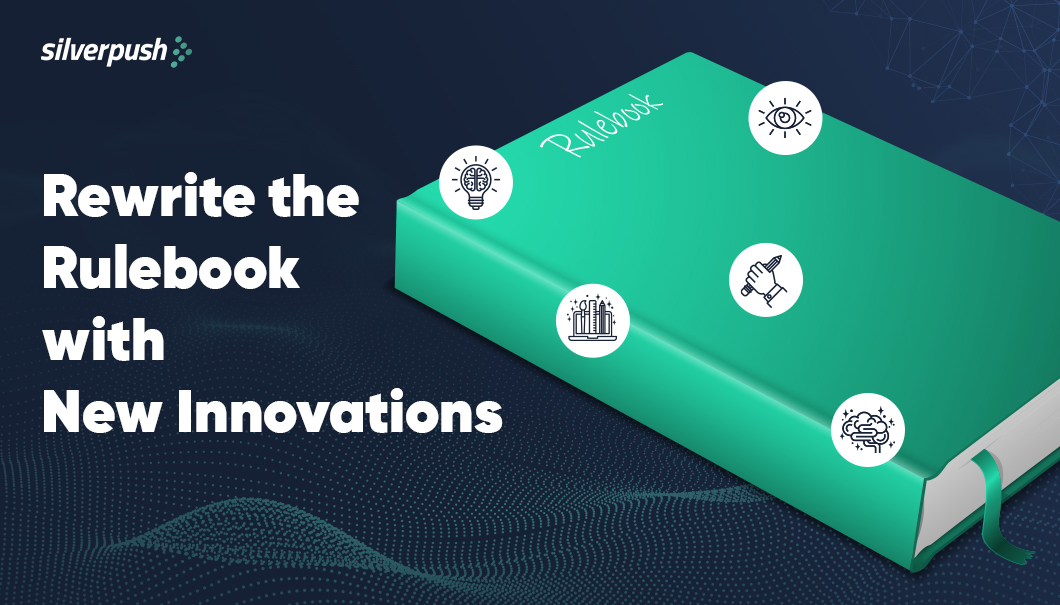
In the fast-paced world of advertising, the saying “Good things come to those who wait” couldn’t be further from the truth. In an era where technology evolves rapidly, and consumer behavior constantly shifts, advertisers clinging to outdated and monotonous campaign strategies may find themselves drifting away from valuable business opportunities.
Discover the Trends Taking Over in 2024
As we step into 2024, it becomes imperative for advertisers to discern and leverage key trends to maintain a competitive edge in this dynamic arena.
Brace yourself for the cookie countdown
The global digital advertising market was valued at $601.8 billion in 2023, with media ads accounting for 67.1% of overall expenditure. Clearly, digital advertising is a lucrative industry, and it’s no surprise that more companies are finding ways to capitalize on this trend. However, as more companies seek to tap into this thriving trend, it’s essential to address the impending challenge of cookie deprecation and its potential impact on advertisers and digital advertising revenue.
Google has outlined its plan to phase out third-party cookies entirely by the conclusion of 2024, and efforts are already underway to implement this transition. The initial measure involves the introduction of Privacy Sandbox Tracking Protection, which will be experienced by 1% of Chrome users globally. This feature aims to restrict cross-site tracking by default.
Focus will be more on Personalization and Hyper-Targeting
“One-size-fits-all” approach won’t be effective anymore. With abundance of information and choices consumers today expect to be catered with relevant ads, they want brands to directly speak to them based on their interests, needs and preferences.
70% of consumers expect personalization and 56% agreed that personalized experience motivates them to become a repeat customer. (Source)
From a business point of view, personalisation helped 77% of businesses increase their market share. This form of marketing has increased conversions nearly 50% for brands. (Source)
Brands that don’t invest in understanding their audience and delivering tailored content are at the risk of losing customer engagement.
Video Content Dominance
Video content will continue to dominate the existing ad formats, as billions of viewers tune in. According to stats, 2023 had seen a 23% surge in internet traffic volume globally, escalating usage of streaming videos. (source)
But, advertisers need to be mindful of the video length, as consumer attention span and patience is getting shorter. More than 25% of adults close a video after 10 seconds and approximately 50% of the viewers close it after 20 seconds. (source)
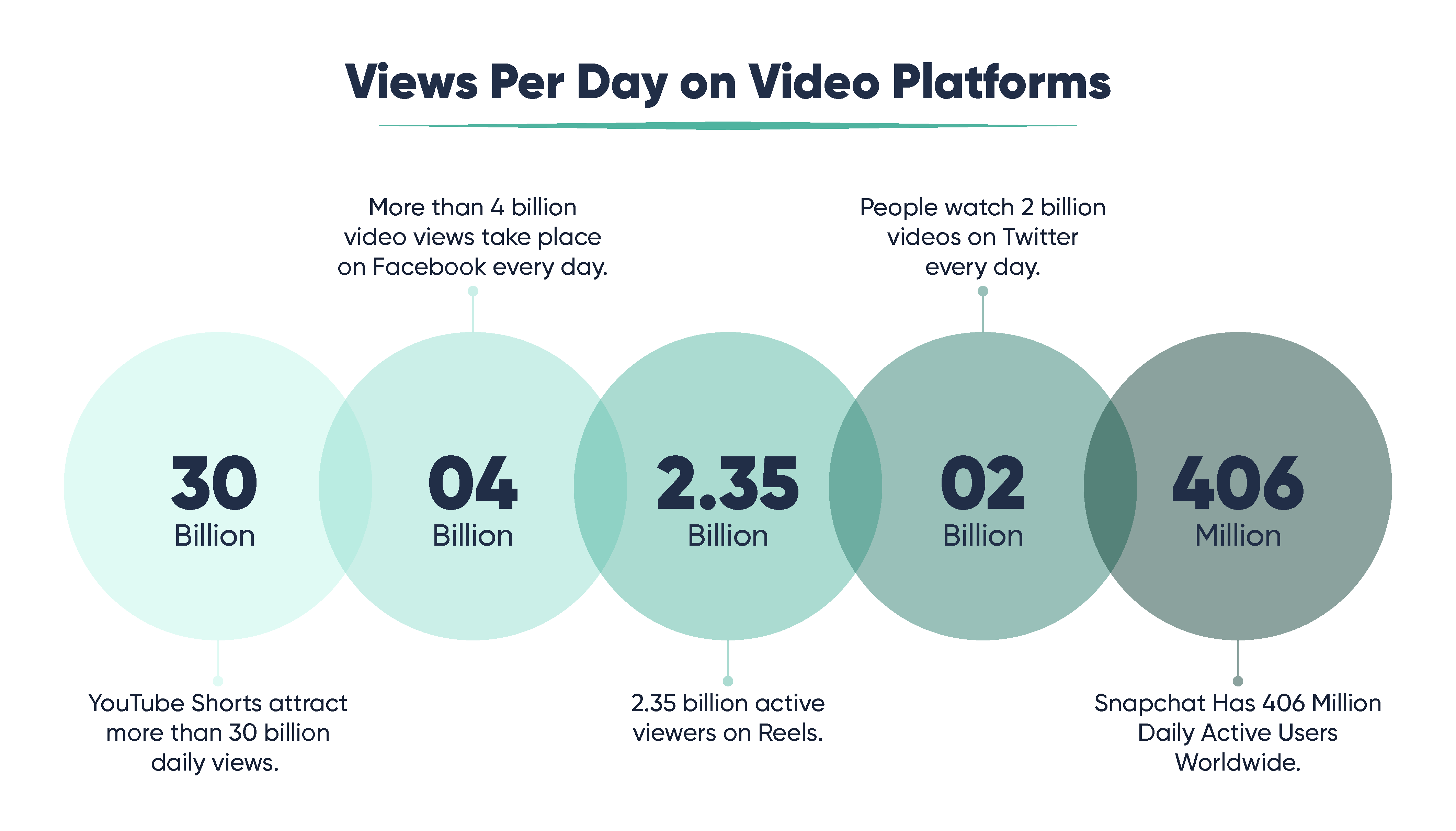
Brands should focus on creating high-quality and engaging video content for platforms like YouTube, TikTok, and Instagram. This trend is especially important as attention spans decrease, and visual storytelling becomes more critical.
Interactive Content
Since video content is gaining popularity advertisers need to advance their video advertising strategies. From the traditional video ads there is going to be an upgrade to dynamic interactive video ads.
To drive more engagement and conversion, advertisers should incline towards dynamic video ads as a result they have noted significant growth in their online sales.
Interactive content, such as polls, quizzes, and augmented reality experiences, not only captures attention but also provides a more immersive brand experience.
Among the interactive elements, shoppable TV ads have proven to be highly effective for cutting through the noise and boosting customer engagement due to their interactive nature. According to a survey, Shoppable ads have 55% ad recall and 50% interacting rate.
Role of Generative AI
Generative AI can process large amounts of data and generate valuable insights that can inform strategic decisions in campaign planning. Additionally, AI algorithms can analyze diverse datasets to identify and create new audience segments. Using these insights, advertisers can tailor their campaigns to specific demographics, ensuring more targeted and effective advertising.
Advertisers are using predictive analytics to analyze historical data and gain insights into user behavior, enabling them to optimize their campaigns further.
Conclusion
The advertising industry heavily relies on AI for campaign planning, execution, and optimization. Generative AI is changing the game by actively participating in the process. To achieve maximum success, brands should stay up-to-date with the latest trends in advertising and incorporate generative AI into their campaigns. This will provide advertisers with unparalleled levels of data analysis, audience segmentation, and dynamic content creation, leading to more efficient and personalized targeted advertising that can significantly boost the impact of campaigns. In a constantly evolving landscape, innovation is crucial to maintain growth and market dominance. Brands that embrace the potential of generative AI and adapt their strategies accordingly can exceed the expectations of the ever-changing consumer base. This will ensure a prosperous future in the dynamic world of advertising.
Safe and Sound: Building a Fortified Online Presence for Your Brand
PUBLISH DATE: 26 December 2023
In the digital age, where a brand’s reputation is built and broken online, brand safety has emerged as a critical business imperative. It goes beyond simply avoiding harmful content; it’s about strategically managing your brand’s online presence and ensuring it appears in environments that are aligned with your values, resonate with your target audience, and ultimately contribute to your overall business goals.
What is Brand Safety?
In essence, brand safety encompasses a set of measures, guidelines, and practices to ensure that a brand’s advertising does not appear in contexts that could potentially harm its image. This is especially crucial in the world of digital advertising, where programmatic placements might lead to ads appearing alongside off-brand, offensive, or controversial content.
Brand safety is a paramount concern for advertisers today, focusing on safeguarding the reputation of their brands and preventing them from associating with negative environments. The Global Alliance for Responsible Media (GARM) has developed the GARM: Brand Safety Floor + Suitability Framework to aid brands in maintaining their reputation by avoiding harmful or inappropriate content.
Critical components of brand safety include:
- Contextual Relevance: Guaranteeing that ad content is not only appropriate but also relevant to the content of the webpage, video, or other media in which it is displayed.
- Quality of Placement: Ensuring that ads are featured on websites or media outlets that align with the brand’s values and quality standards.
- Content Exclusions: Employing negative keyword lists, blocklists, or other filtering tools to prevent ads from being displayed next to specific types of content.
- Compliance and Regulation: Ensuring that ad placements adhere to industry regulations, which may vary by country, encompassing guidelines on advertising for products like tobacco, alcohol, or pharmaceuticals.
- Audience Targeting: Confirming that ads are directed at a demographic that is not only suitable but also intended for the advertised product or service.
Why Does it Matter?
Imagine your brand’s carefully crafted ad appearing next to a controversial news article or an offensive video. The resulting damage to your brand image could be significant, leading to lost sales, customer churn, and a negative public perception.
A 2021 US survey revealed that 80% of respondents expressed concern about brands appearing alongside negative content online. This statistic underscores the importance of brand safety for businesses of all sizes, regardless of industry or target audience.

Several factors pose significant risks to brand safety in the ever-evolving digital landscape:
1. The Social Media Frontier: Over time, social media has become a globally acknowledged source of truth. A well-crafted social media presence plays a crucial role in establishing a brand’s identity. Individuals prefer staying informed and closely monitoring their favored brands on social platforms. However, the dual nature of social media poses both advantages and challenges.
While it serves as an excellent avenue for brand promotion and interaction with customers and enthusiasts, it also carries the risk of brand reputation damage if ads appear alongside objectionable content. This powerful tool’s accessibility has led to instances where internet users have criticized brands for inappropriate content, imagery, or placement next to questionable material or pages.
To ensure brand safety, meticulous attention is required in areas such as ad strategy, and monitoring mentions, comments, and appearances. Marketers must remain vigilant against impostors and identity thieves capable of causing significant harm through fraudulent activities or posting unsavory content.
2. The Perils of Ad Fraud: In an industry valued at over US$ 640 billion, fraudulent activities are inevitable. Dubious websites, often assisted by bots, generate false clicks and attract ads, leading to significant financial losses for advertisers every month. It is imperative for marketers to ascertain whether their ads genuinely reach the intended audience, exercise control over ad impressions, and measure the quality of impressions and clicks.
The impact on brand safety is notable, with adult websites being a major contributor to ad fraud. An esteemed brand’s ad appearing alongside adult content can severely damage its image. While keyword block lists are useful, they alone cannot guarantee brand safety, and the practice may have unintended consequences.
3. The Pitfall of Poor Ad Placement: Ad placements are not just about reaching a large audience; they are about ensuring your brand appears in the right context. Placing ads on websites that are inconsistent with your brand values or target audience can lead to negative associations and erode your brand image.
A common mistake among marketers and advertisers is the oversight of ad placement strategy. Reports have criticized YouTube for displaying ads from renowned brands alongside misinformation and conspiratorial content. Emphasizing the importance of ad placements is crucial, as they significantly impact a brand’s image.
Striking the Perfect Balance of Brand Safety with Contextual
Contextual targeting offers a powerful solution to the challenges of brand safety. This innovative technology utilizes artificial intelligence, including Natural Language Processing (NLP) and Sentiment Analysis, to understand the context of web pages and online environments. By analyzing the written and visual content, contextual targeting enables brands to place their ads on relevant websites with content that aligns with their brand values and resonates with their target audience.
Mirrors by Silverpush: Your Trusted Partner in Brand Safety
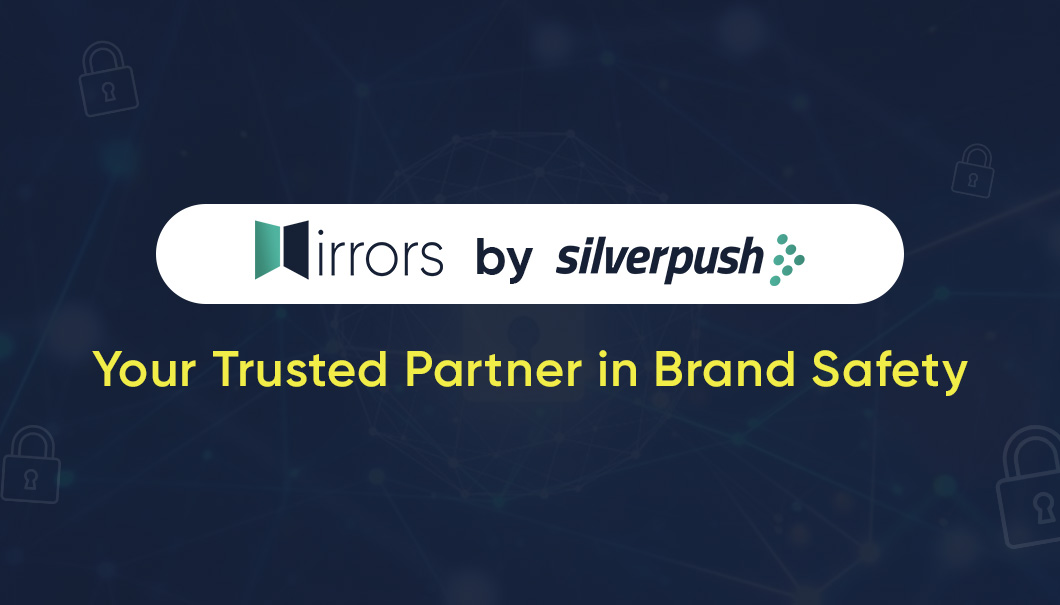
Mirrors by Silverpush is a cutting-edge contextual targeting platform designed to help brands achieve their goals while maintaining the highest levels of brand safety. Utilizing sophisticated AI algorithms and advanced language models, Mirrors analyzes the written and visual content of web pages, ensuring that your ads appear in safe and brand-aligned environments. With Mirrors, you can:
- Protect your brand reputation through intelligent ad placement.
- Reach your target audience with precision and relevance.
- Gain valuable insights into your audience’s behavior and preferences.
- Optimize your campaigns for maximum effectiveness and return on investment.
In conclusion, brand safety is no longer a luxury; it’s a necessity for businesses operating in the digital world. Innovative solutions like contextual targeting and partnering with trusted solutions like Mirrors, brands can ensure their reputation is safeguarded, their advertising efforts are effective, and their overall business objectives are achieved.
Contextual Isn’t New, but Advancements Will Solve Marketers’ Headaches
PUBLISH DATE: 13 December 2023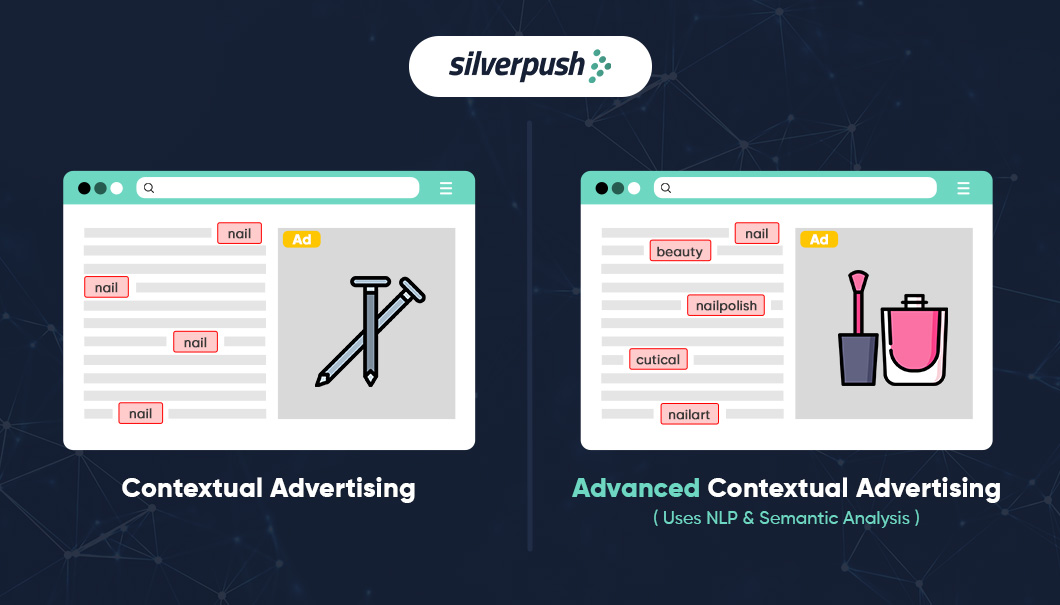
Contextual advertising is on the surge, according to projection it will reach 427.40 billion by 2029.
Since 2018, the advertising landscape has been under the seismic shift. Privacy centric shifts in the form of guidelines by GDPR and CCPA and initiatives by Apple and Android have become the talk of the town.
After banning third-party cookies from Safari, Apple launched its App Tracking Transparency in 2021. With ATT in the picture, apps are required to obtain explicit user consent before tracking their activity.
Similar action was taken by Android OS in 2023 where they launched the beta version of Android Privacy Sandbox. Google is working on a strategic phase-out of the cookies by 2024.
This was just a background picture of how contextual advertising gained limelight once again!
Advertisers turned to contextual targeting as it was easy and offered compliant targeting at scale. But this approach came with its own set of challenges.
Drawbacks of the Existing Contextual Approach
The conventional contextual advertising relies on the understanding of the environment in which the ad is displayed. The traditional method of contextual targeting was limited to the placement of ads based on the webpage content. This was primarily done by analyzing the keywords of the webpage.
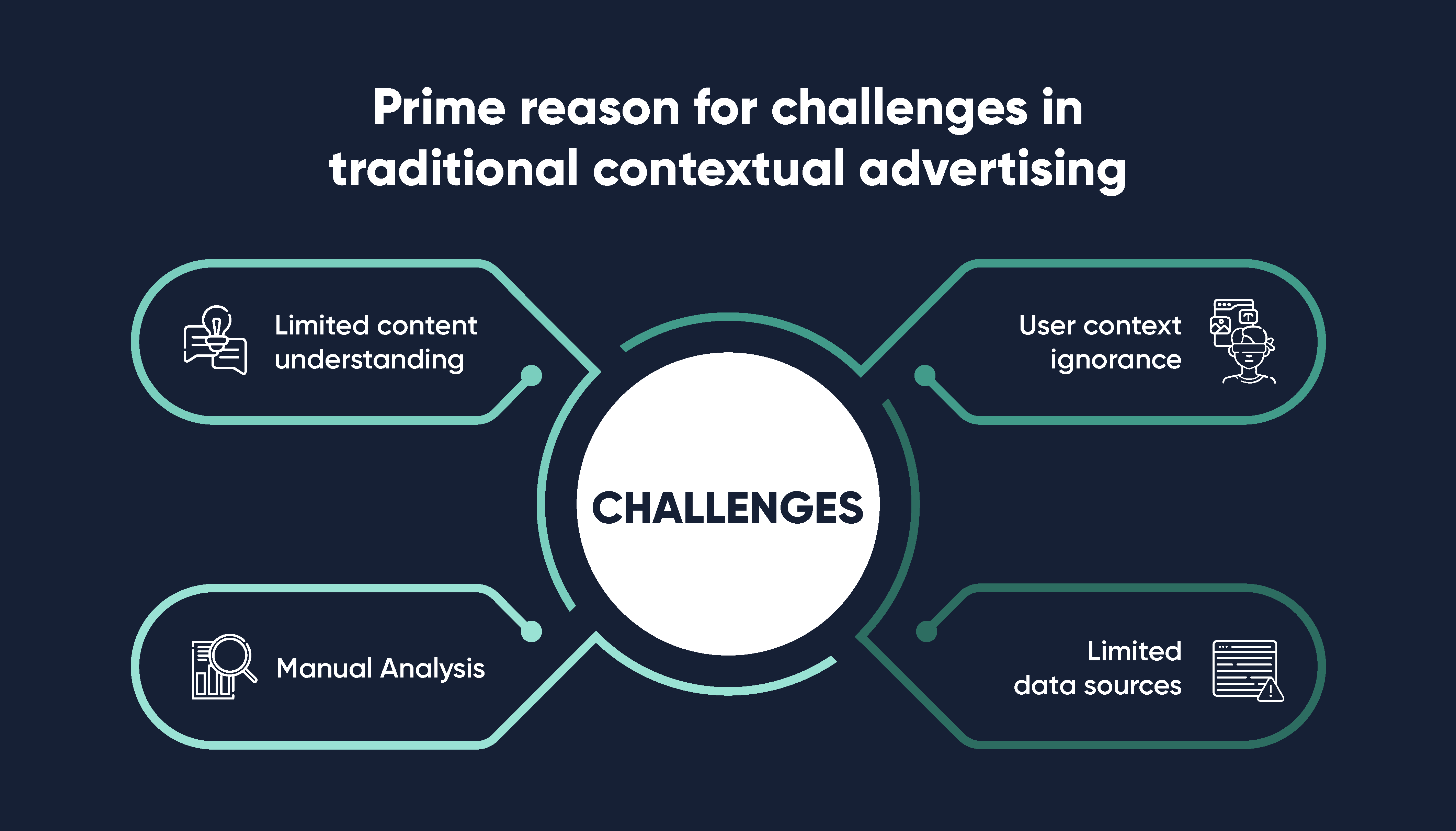
Traditional approach is relatively simple and straightforward but it lacked in reaching the consumer who would be actively interested. Other challenges that occurred with traditional contextual advertising were:
- Imprecision: The understanding of the page’s content was limited which sometimes resulted in the irrelevant ad placement.
- Reach: The reach was a significant issue with traditional approach as it lacked granular targeting and often missed the active users who would have been interested in the ad. Traditional contextual advertising often struggles to reach a sufficiently large audience due to the following factors:
- Scalability: Scalability is a major challenge in traditional contextual advertising due to the sheer volume of web pages and the need for real-time ad placement. Traditional contextual advertising relies on manual analysis of webpage content to determine its relevance for ad placement. This process is extremely time-consuming and labor-intensive, making it impractical for handling the vast amount of content that exists online.
AI-Powered Contextual Advertising: Smarter Targeting Approach in Privacy-First Era
The advent of AI-powered contextual targeting has marked a significant shift. In leveraging technology, advertisers now have the means to overcome these challenges. This innovative approach enables a more nuanced understanding of content, ensuring precise targeting, broader reach, and improved scalability, thereby revolutionizing the effectiveness of contextual advertising in the contemporary advertising landscape.
Contextual Advertising Re-engineered as Targeting Approach
The acceleration of the new generation of contextual advertising can be attributed to the evolution of machine learning and artificial intelligence (AI). In navigating the challenges posed by stringent data regulations, AI-powered contextual solutions play a pivotal role in shaping the success or failure of advertising endeavors.
Advanced contextual targeting, fueled by natural language processing (NLP), semantic analysis, and machine learning, has emerged as a game-changer. By delving deeper into content, context, and user intent, it effectively addresses issues of scalability, reach, and imprecision. The re-engineered contextual advertising paradigm prioritizes data acquisition, empowering advertisers with data-driven targeting solutions.

This evolution goes beyond traditional keyword targeting, employing NLP and semantic analysis to comprehend webpage content comprehensively, including text, images, and videos. Machine learning further enhances advertising opportunities by analyzing vast datasets, and predictive AI leverages existing consumer behavior data to inform targeted strategies.
Silverpush, through its advanced contextual targeting solution, Mirrors, adopts a dual approach. The AI-powered contextual solution identifies key contexts across webpages on the Openweb to extract contextual signals for advertising opportunities. Simultaneously, it conducts a thorough analysis of historical consumer behavior data, enabling predictions of audience personas and likely actions.
In a comprehensive view, Silverpush empowers advertisers to tap into previously unexplored market segments through its omnichannel contextual solution. This is achieved within a brand-safe and suitable environment, ensuring a holistic and effective advertising strategy.
Conclusion
In today’s digital world, advertisers use contextual targeting to reach specific audiences. Privacy is crucial, and transparency is key for advertisers to stand out. In the era without cookies, advanced contextual targeting is a safe and effective choice. It not only keeps users secure but also ensures brand safety. When ads are relevant to users, it greatly improves brand safety, giving advertisers a smart edge in today’s advertising landscape.


